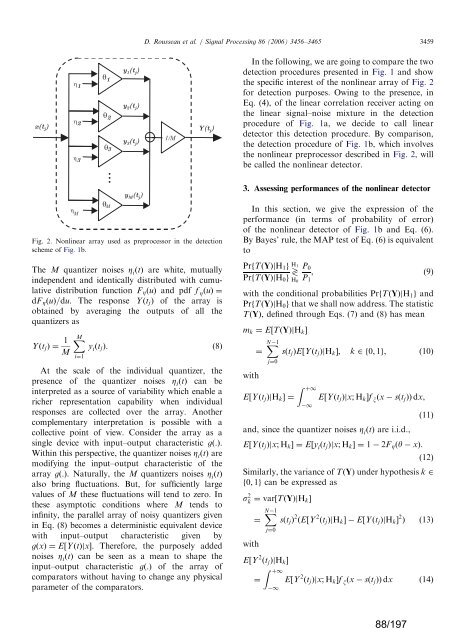a la physique de l'information - Lisa - Université d'Angers
a la physique de l'information - Lisa - Université d'Angers
a la physique de l'information - Lisa - Université d'Angers
You also want an ePaper? Increase the reach of your titles
YUMPU automatically turns print PDFs into web optimized ePapers that Google loves.
Fig. 2. Nonlinear array used as preprocessor in the <strong>de</strong>tection<br />
scheme of Fig. 1b.<br />
The M quantizer noises ZiðtÞ are white, mutually<br />
in<strong>de</strong>pen<strong>de</strong>nt and i<strong>de</strong>ntically distributed with cumu<strong>la</strong>tive<br />
distribution function F ZðuÞ and pdf f ZðuÞ ¼<br />
dF ZðuÞ=du. The response YðtjÞ of the array is<br />
obtained by averaging the outputs of all the<br />
quantizers as<br />
YðtjÞ ¼ 1 X<br />
M<br />
M<br />
yiðtjÞ. (8)<br />
i¼1<br />
At the scale of the individual quantizer, the<br />
presence of the quantizer noises ZiðtÞ can be<br />
interpreted as a source of variability which enable a<br />
richer representation capability when individual<br />
responses are collected over the array. Another<br />
complementary interpretation is possible with a<br />
collective point of view. Consi<strong>de</strong>r the array as a<br />
single <strong>de</strong>vice with input–output characteristic gð:Þ.<br />
Within this perspective, the quantizer noises ZiðtÞ are<br />
modifying the input–output characteristic of the<br />
array gð:Þ. Naturally, the M quantizers noises ZiðtÞ also bring fluctuations. But, for sufficiently <strong>la</strong>rge<br />
values of M these fluctuations will tend to zero. In<br />
these asymptotic conditions where M tends to<br />
infinity, the parallel array of noisy quantizers given<br />
in Eq. (8) becomes a <strong>de</strong>terministic equivalent <strong>de</strong>vice<br />
with input–output characteristic given by<br />
gðxÞ ¼E½YðtÞjxŠ. Therefore, the purposely ad<strong>de</strong>d<br />
noises ZiðtÞ can be seen as a mean to shape the<br />
input–output characteristic gð:Þ of the array of<br />
comparators without having to change any physical<br />
parameter of the comparators.<br />
ARTICLE IN PRESS<br />
D. Rousseau et al. / Signal Processing 86 (2006) 3456–3465 3459<br />
In the following, we are going to compare the two<br />
<strong>de</strong>tection procedures presented in Fig. 1 and show<br />
the specific interest of the nonlinear array of Fig. 2<br />
for <strong>de</strong>tection purposes. Owing to the presence, in<br />
Eq. (4), of the linear corre<strong>la</strong>tion receiver acting on<br />
the linear signal–noise mixture in the <strong>de</strong>tection<br />
procedure of Fig. 1a, we <strong>de</strong>ci<strong>de</strong> to call linear<br />
<strong>de</strong>tector this <strong>de</strong>tection procedure. By comparison,<br />
the <strong>de</strong>tection procedure of Fig. 1b, which involves<br />
the nonlinear preprocessor <strong>de</strong>scribed in Fig. 2, will<br />
be called the nonlinear <strong>de</strong>tector.<br />
3. Assessing performances of the nonlinear <strong>de</strong>tector<br />
In this section, we give the expression of the<br />
performance (in terms of probability of error)<br />
of the nonlinear <strong>de</strong>tector of Fig. 1b and Eq. (6).<br />
By Bayes’ rule, the MAP test of Eq. (6) is equivalent<br />
to<br />
PrfTðYÞjH1g<br />
PrfTðYÞjH0g _H1<br />
P0<br />
H0 P1<br />
, (9)<br />
with the conditional probabilities PrfTðYÞjH1g and<br />
PrfTðYÞjH0g that we shall now address. The statistic<br />
TðYÞ, <strong>de</strong>fined through Eqs. (7) and (8) has mean<br />
mk ¼ E½TðYÞjHkŠ<br />
with<br />
¼<br />
XN 1<br />
j¼0<br />
E½YðtjÞjHkŠ ¼<br />
sðtjÞE½YðtjÞjHkŠ; k 2f0; 1g, ð10Þ<br />
Z þ1<br />
1<br />
E½YðtjÞjx; HkŠf xðx sðtjÞÞ dx,<br />
(11)<br />
and, since the quantizer noises ZiðtÞ are i.i.d.,<br />
E½YðtjÞjx; HkŠ ¼E½yiðtjÞjx; HkŠ ¼1 2F Zðy xÞ.<br />
(12)<br />
Simi<strong>la</strong>rly, the variance of TðYÞ un<strong>de</strong>r hypothesis k 2<br />
f0; 1g can be expressed as<br />
s 2 k<br />
¼ var½TðYÞjHkŠ<br />
¼<br />
with<br />
XN 1<br />
j¼0<br />
E½Y 2 ðtjÞjHkŠ<br />
¼<br />
Z þ1<br />
1<br />
sðtjÞ 2 ðE½Y 2 ðtjÞjHkŠ E½YðtjÞjHkŠ 2 Þ ð13Þ<br />
E½Y 2 ðtjÞjx; HkŠf xðx sðtjÞÞ dx ð14Þ<br />
88/197


